 Get premium membership
Get premium membership and access revision papers with marking schemes, video lessons and live classes.
Class 8 Science End of Term 2 Examination 2021
Class: Class 8
Subject: Science
Level: Primary School
Exam Category: Class 8 End Term 2 Exams
Document Type: Pdf
Views: 1092
Downloads: 44
Exam Summary
SCIENCE CLASS 8 TERM 2 2021
1. Objects either in motion or stationary remain at the same state unless a force is applied. This is due to principle.
A. Weight.
B. Inertia.
C. Friction.
D. Density
2. Which of the following is the correct order of development stages of a baby during pregnancy?
A. Foetus, embryo, zygote
B. Embryo, zygote, foetus
C. Zygote, foetus, embryo
D. Zygote, embryo, foetus
3. Plants which feed on dead decaying matter are called _______
A. Mushrooms
B. Saprophytes
C. Parasites
D. Creepers
4. The type of roots found near the base of maize stems are used for
A. Absorbing water
B. Absorbing mineral salts
C. Breathing
D. Offering extra support
5. Which of the following feeds is not common in zero grazing?
A. Fodder
B. Silage
C. Pasture
D. Hay
6. Which one of the following is NOT part of a food chain?
A. Photosynthesis
B. Consumer
C. Producer
D. Decomposer
7. Which one of the following crops is NOT attacked by stalk borers?
A. Maize
B. Beans
C. Sugarcane
D. Sorghum
The pie chart below shows the approximate composition of air

8. Which part represents the part of the air required for germination to take place?
A. W
B. X
C. Y
D. Z
Use the diagram below to answer questions 8-11
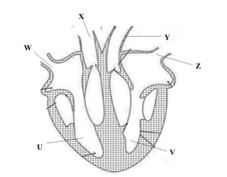
9. The blood vessel marked X is the
A. Aorta
B. Vena cava
C. Pulmonary vein
D. Pulmonary artery
10. Which of the following statements is NOT correct? The blood vessel marked Y
A. Carries deoxygenated blood
B. Is the major artery in the circulatory system?
C. Carries blood to the body organs
D. Is the aorta
11. The blood vessel marked Z is
A. carries blood from the lungs
B. is the pulmonary artery
C. is the aorta
D. carries dull red blood
12. Which one of the following is NOT a narcotic drug?
Tobacco
B. Mandrax
C. Heroin
D. Cocaine
13. Which one of the following methods of food preservation renders the bacteria inactive and not dead?
A. Drying
B. Salting
C. Smoking
D. Use of low temperature
14. The diagram below shows change of state in matter
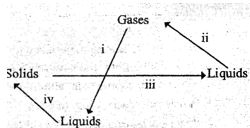
Which letter represents the process of melting
A. i
B. iii
C. iv
D. v
15. The movement of heat through liquids such as water takes place by
A. Conduction
B. Radiation only
C. Convection only
D. Radiation and convection
16. Which one of the following materials is non-magnetic?
A. Iron rod
B. Aluminum foil
C. Cobalt strip
D. Nickel coin
17. External livestock parasites can be controlled through the following ways EXCEPT?
A. Deworming
B. Spraying
C. Dipping
D. Rotational grazing
18. Which one of the following pairs DOES NOT constitute the living parts of the environment?
A. Animals and Soil
B. Plants and Water
C. Light and Air
D. Sound and Plants
19. Gulley erosion can be BEST controlled by;
A. Making terraces
B. Mulching
C. Digging trenches
D. Constructing porous dams
20. Which one of the following is NOT an effect of water pollution on animals and plants life?
A. Leading to soil infertility
B. Leading to infection on animals
C. Destruction of aquatic plants
D. Blockage of root hairs.
21. The following are characteristics of insect pollinated flower. Which one is NOT
A. Large coloured petals
B. Brightly coloured sepals.
C. Nectary at the base of the flower
D. Heavy and sticky pollen grain
22. Materials which allow light to pass through them but one cannot see through them are said to be;
A. Opaque
B. Translucent
C. Transparent
D. Reflectors
23. The process of providing the body with food necessary for maintenance of good health is called
A. Feeding
B. Balance diet
C. Nutrition
D. Body building
24. Which of the following is both a field and a storage pest?
A. Aphids
B Cutworm
C. Weevil
D. Stalk borer
25. Which one of the following components of the environment occupies the LARGEST part of the earth’s surface
A. Water
B. Air
B. Soil
D. Plant
26. Using water sparingly as a way of conserving water will involve doing all the following EXCEPT
A. Using used water again.
B. Turning off taps after use
C. Practicing drip irrigation method
D. Fixing leakages in taps and pipes
27. Study the experiment shown below
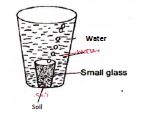
The experiment was LIKELY set to show the presence of
A. Water in Air
B. Air in the soil
C. Water in the soil
D. Air in water
28. Which one of the following can mix well and form one uniform solution?
A. Paraffin and water
B. Water and spirit
C. Milk and spirit
D. Water and cooking oil
29. Which one of the following is the BEST medium for sound transmission
A. Air
B. Liquid
C. Vacuum
D. wood
30. The unit for measuring force is
A. Newton
B. Kilograms
C. Grams
D. Joules
31. Absorptions of water and mineral salts takes place where?
A. Stomach
B. Duodenum
C. Ileum
D. Oesophugus
32. Which one following are water borne diseases?
A. Cholera
B. Tuberculosis
C. Malaria
D. Pneumonia
33. The experiment drawn below can be used by learners to understand that;
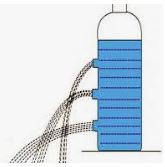
A. Liquid exert pressure to all directions
B. Liquid exert more pressure with depth
C. Pressure in liquids is equal at its same depth
D. Liquid takes the shape of the container
34. An animal attacked by parasite is NOT likely to show one of the following signs. Which one?
A. Rise in body temperature
B. Loss of appetite
C. Rough hair
D. Chewing the cud
35. Which one of the following statements BEST explains the term cross pollination?
A. The transfer of pollen grains from the anthers to the stigma of another flower.
B. The fusion of pollen and ovule nucleus
C. The transfer of pollen grain from the male anthers to female stigma of another flower of the same type on the same plant.
D. The transfer of pollen grains from the anther to the stigma of another flower on another plant of the same kind.
36. Which two parts of the breathing system have hair and mucus?
A. Air Sacs, nose.
B. Nose, Trachea.
C. Nose, bronchus.
D. Nose, lungs.
D. Density.
37. Which of the following crops is a stem tuber?
A. Carrot.
B. Sweet potato.
C. Irish potato.
D. Cassava.
38. Standard eight pupils mixed soap and hard water. Which of the following substances did they observe?
A. Fur.
B. Scum.
C. Lather.
D. Scale.
39. Which of the following consists of materials that can be attracted by a magnet ONLY?
A. Nickel, copper, cobalt. . .
B. Copper, chromium, silver.
C. Iron, steel, cobalt.
D. Chromium, tin, aluminum.
40. The diagram below shows the internal parts of a maize grain. K L M
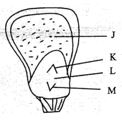
Which letter represents the part that stores food?
A. J.
B.K.
C. L.
D. M
41. Standard five pupils grouped small animals as shown below.
Group A- beetle, spider, tick.
Group B - aphid, weevil, moth.
Group C-- ladybird, mite, and ant.
Group D - spider, moth, tick. Which group grouped the small animals correctly?
A Group A.
B. Group B
C. Group C.
D. Group D.
42. Which of the following methods of grazing can one practice in areas that have high population? A. Paddocking.
B. Stall feeding.
C. Strip grazing.
D. Herding.

43. Standard eight pupils observed the bird shown below The _bird shown above is likely to be found in
A. Flower bed.
B. River.
C. Swamp.
D. Forest.
44. The following are different ways of conserving the soil. Which one mainly conserves soil moisture?
A. Terracing.
B. Crop rotation.
C. Cover cropping.
D. Mulching.
45. Which of the following components of air make up a fifth of air by volume?
A. Oxygen.
B. Rare gases.
C. Carbon dioxide.
D. Nitrogen.
46. Which one of the following is not a feature of plants that grow in dry areas?
A. They have deep root to look for water.
B. They have thin waxy cuticles on their leaves
C. They have needle like leaves.
D. They have fleshy stems for storing water
47. An iron bowl float on water mainly due to;
A. materials
B. shape
C. size
D. mass
48. Which instrument below can be used to demonstrate effect of heat on matter?
A. Windvane.
B. Raingauge.
C. Wind sock.
D. Air thermometer.
49. Which one of the following animal feeds cannot be fed on livestock under zero grazing?
A. pasture
B. fodder
C. silage
D. concentrates
50. Which one of the following is the main reason why farmers apply mulch?
A. To control soil erosion
B. To control feeds
C. To control pests
D. To conserve moisture
More Examination Papers